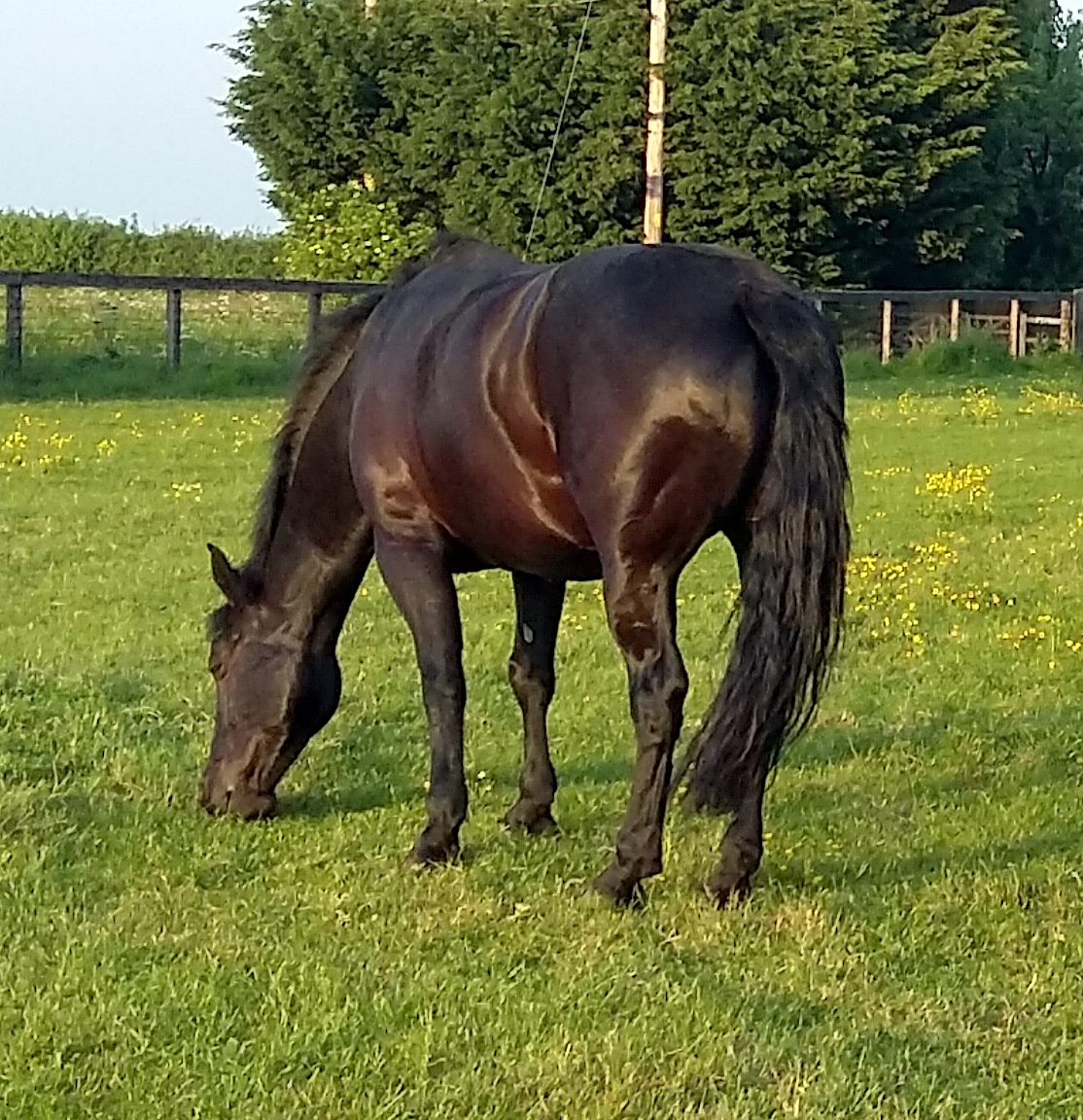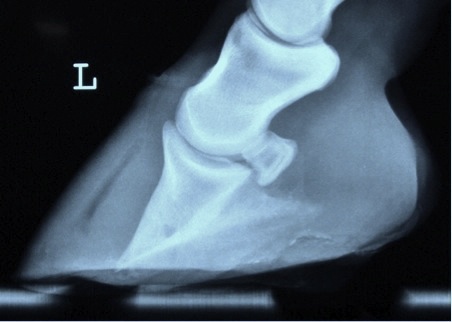Turning up the HEAT Equine health during the summer months By Lucy Grieve MA VetMB MRCVS

The summer months can bring a number of health issues for horses and ponies, some of the common ones are highlighted here.
Excess Weight
Many horses and ponies are turned out 24 hours a day at this time of year. While a paddock may not look ‘green’, the little grass that is there can be rich in sugars and horses may easily gain weight and be at high risk of laminitis. Ideally, changes in weight should be monitored regularly using a weigh tape and a body condition scoring system. Feed/hay/grazing can then be adjusted as necessary to avoid gaining weight, which will be much harder to lose again. The various equine charities and nutrition companies recommend different condition scoring systems, but choose one that works for you and use it consistently to monitor changes. Occasional access to a weighbridge for an accurate measurement is helpful but not essential.
For advice on weight management, contact your vet or a qualified nutritionist.

Changes in weight should be monitored regularly with a weigh tape

Laminitis

A horse with a rotated pedal bone resulting from chronic laminitis
Signs of acute laminitis range from subtle (warm feet and increased digital pulses) to more obvious (reluctance to move and the typical “laminitic stance”). Chronic laminitis tends to result in visible changes to the foot, reflecting altered hoof growth and movement of the pedal bone.
If you suspect laminitis, contact your vet immediately.
Shelter and Insect Protection
Your horse or pony should have access to shelter from the sun, heat and where possible, biting insects such as horseflies and midges. This can be good tree coverage throughout the day, a field shelter or stabling at appropriate times of day. Stables and field shelters should be well-ventilated and as free from dust as possible. Use insect repellent, fly masks and fly rugs to prevent bites. Regularly removing manure from fields not only helps control worms, but avoids attracting flies. Similarly, prevent build up of stagnant/standing water, because it provides a breeding ground for biting insects.
Sunburn/Photosensitisation
Horses with any pink skin are at risk of sunburn (usually face and limbs). Apply high factor sun cream regularly to prevent redness, discomfort, blistering and peeling.
UV protective face masks, which cover the head and muzzle, and turnout sheets can provide more extensive protection.
For severe or uncontrolled cases, seek veterinary advice.

Horses with pink skin are at risk of sunburn and require the application of high factor sun cream to those areas
Allergies
An allergy is an overreaction of the immune system to a usually harmless substance. The substance responsible is called the ‘allergen’, and these are broadly categorised as follows:
• Skin allergens: skin contact, for example ‘sweet itch’, a hypersensitivity to the biting Culicoides midge.
They commonly cause itchy skin (pruritus), hives/wheals (urticaria), and sometimes hair loss.
• Respiratory allergens: usually inhaled, such as dust, mould and pollen.
• Ingested allergens: usually eaten, for example seasonal plants suspected of causing 'grass glands’.
Skin conditions are usually diagnosed using the animal’s history, but may require a hair pluck, skin scrape or biopsy sample to be examined in a laboratory. Diagnosing respiratory allergies again depends on a detailed history, but may also require endoscopy examination and a sample of fluid being sent for laboratory analysis. Ingested allergies are often only identified using the history and a frequently lengthy process of elimination. The best approach to tackling allergies is to eliminate the allergen from your horse or pony's environment. However, this is not always possible and so a combination of reducing the allergen, protecting from it and symptomatic treatment may be used.
Tailored management strategies can be discussed with your vet.
Dehydration
During hot weather your horse or pony’s water intake will increase, and they should always have access to a clean and plentiful supply to prevent dehydration. If there are several horses in a field, provide more than one source of water so that dominant horses can't prevent subordinate ones from drinking. When travelling and competing always take plenty of fresh water from home (some horses don't like water which tastes different). On a long journey, stop regularly to offer your horse a drink and check he is not overheating. Apple juice or mint cordial can be used to encourage a fussy drinker.
Electrolyte supplementation
Ideally horses should have free access to a salt/mineral block so they can regulate themselves. However, prolonged or repeated sweating can result in electrolyte loss, which the horse may struggle to replenish easily. Supplementing those horses with salt or electrolytes (powders or pastes are commercially available) may be necessary. There are many to choose from and getting the right one and right dose is important to avoid doing more harm than good. As such it is advised you discuss this with your vet prior to any hot weather, competition or long journeys.
Exercise, Travel and Competing
When temperatures suddenly rise, horses will not be acclimatised to working in those conditions and preferably should not be worked during the hottest part of the day. Trailers and lorries can become extremely hot, particularly when stationary in traffic. Unless you have air conditioning or a cooling fan in the horse area of your lorry, your horse can become overheated and dehydrated in a short period of time. When competing in hot conditions, reduce warm-up times and be prepared for your horse to tire more quickly. Offer water frequently and especially immediately after competing to reduce the risk of heat related health issues.
Cooling

After exercise horses should be cooled down with plenty of cold water using the 'pour and scrape' method repeatedly. This is the most effective way, as the water heats up quickly on contact with the horse’s body, so it should be scraped away quickly and fresh water poured again to maximise heat removal. Walking the horse keeps air flowing over the body, which aids cooling, and also helps prevent muscle problems.

Heat Stress

Dark urine can be a sign of heat stress
Heat stress, or heat exhaustion, is more common when horses work in excessively hot or humid conditions and is a condition that must be treated promptly. Body temperature can rise dangerously due to massive heat production from the muscles, insufficient heat loss, excessive loss of fluids and electrolytes and oxygen being consumed faster than it is being delivered. The consequences can be serious and sometimes fatal.
Signs of heat stress:
• Heavy and/or rapid breathing (appearing to ‘mouth-breathe’; development of the more serious ‘thumps’)
• Rapid heart rate (sometimes an irregular rhythm)
• Rectal temperature above 39.8°C (about 103.5°F)
• Excessive sweating
• Lethargy or restlessness
• Stumbling or going down
• Muscle spasms
• Kicking out with the back legs
• Slow recovery after exercise
• Dark urine/reduced urination
• Collapse and, in serious cases, convulsions
If your horse displays any of these signs, it is important to use aggressive cooling methods to reduce the horse’s temperature as quickly as possible. It might be necessary for a vet to administer intravenous fluids and/or electrolytes and pain relief.
Always seek veterinary help if you suspect a case of heat stress.
If you have any concerns about potential health issues in your
horse or pony, always contact your vet for advice.
All images in this article are copyright of Rossdales LLP and should not be reproduced.


Vet Profile
Lucy Grieve is an ambulatory assistant at Rossdales Equine Practice in Newmarket.
After qualifying from Cambridge University in 2007, Lucy completed a diagnostic imaging internship at Rossdales Equine Diagnostic Centre. She then spent seven years as an in-house vet for a large flat racing facility in Newmarket.
She returned to Rossdales in 2015, working mainly with pleasure horses and Thoroughbred horses in training. Her main areas of interest are lameness, diagnostic imaging and poor performance.
Lucy has been a member of the British Equine Veterinary Association (BEVA) Council since 2012, serving as chair of the Ethics and Welfare Committee and sitting on the Equestrian Sports Committee, liaising with regulatory bodies such as the BHA and FEI.
She is also co-opted onto the Horserace Betting Levy Board (HBLB) Thoroughbred Research Consultation Group, and was recently invited to sit on the Federation of European Equine Veterinary Associations Welfare Group.
This article can be found in our fantastic JULY ISSUE OUT NOW!














